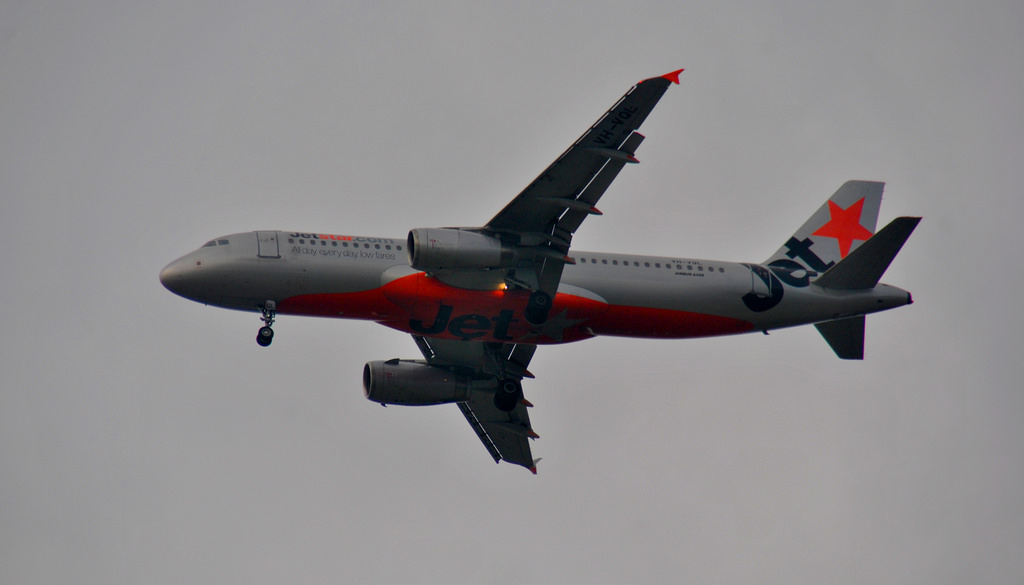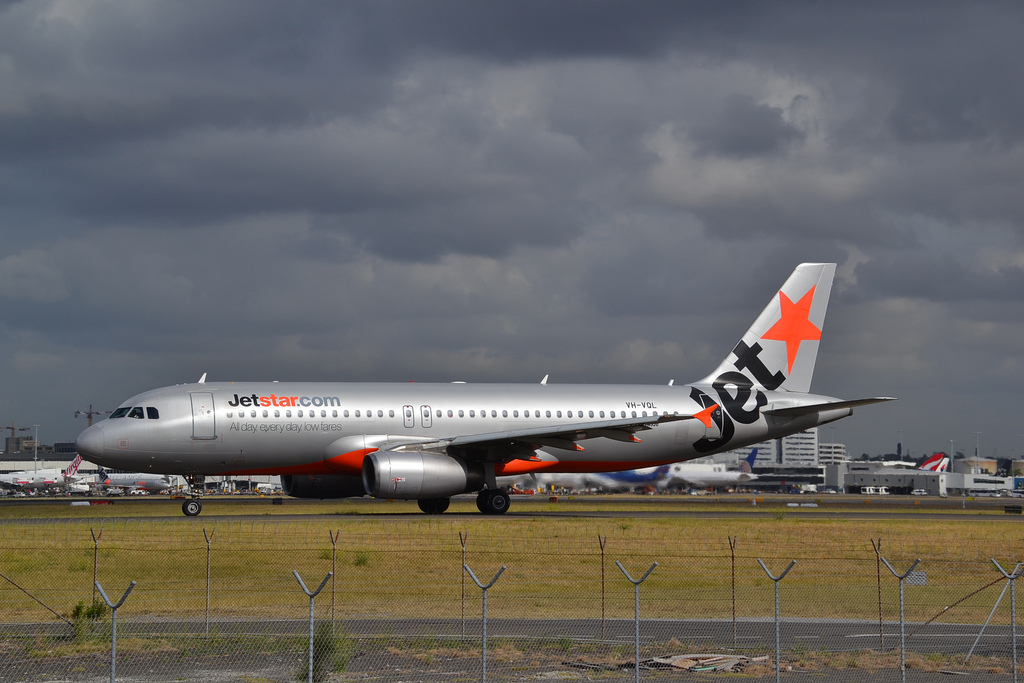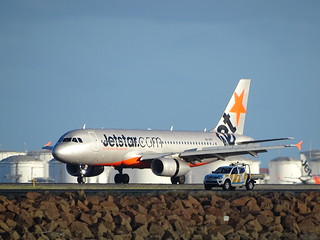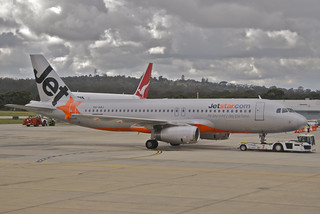Jetstar A320 at Sydney on May 9th 2018, flap and gear overspeed on go around
Last Update: May 7, 2019 / 16:04:29 GMT/Zulu time
Incident Facts
Date of incident
May 9, 2018
Classification
Incident
Airline
Jetstar Airways
Flight number
JQ-608
Departure
Avalon, Australia
Destination
Sydney, Australia
Aircraft Registration
VH-VQL
Aircraft Type
Airbus A320
ICAO Type Designator
A320
The ATSB rated the occurrence an incident and opened an investigation.
On May 7th 2019 the ATSB released their final report concluding the probable causes of the incident were:
While descending through 1,800 ft, the crew inadvertently activated open climb mode with the selection of the assigned altitude selector to 3,000 ft. This resulted in an undetected increase in thrust, which destabilised the approach, and led to the flap overspeed.
- The use of a non-standard go-around procedure, including a lower than required pitch attitude, resulted in increased acceleration and exceedance of the flap and gear limitations.
- The captain's perception of the first officer's level of experience likely led to a shallow cockpit gradient. This influenced the captain's level of intervention during the approach and go-around.
Safety action
The ATSB reported that the aircraft was high on the approach, therefore the crew activated the open descent mode to increase the rate of descent and deployed the speed brakes. The aircraft intercepted the glideslope from above, in the descent set the first stage of flaps, and prior to settings flaps 2 the crew selected the go around altitude of 3000 feet into the FCU and pulled the knob to activate the altitude. This however changed the autopilot mode from open descent to open climb, the engines began to accelerate. Unaware of the thrust increase the crew selected the flaps to 2, the speed increased above the maximum flaps speed by 2 knots. Observing the approach was unstable the captain commanded a go around. The first officer pushed the thrust levers into the TOGA detent, however, did not increase the pitch to 15 degrees nose up, the aircraft accelerated as result, the speed exceeded the flaps 2 speed by 8 knots until the first officer reacted to the captain's pitch and speed calls and selected the flaps to 1. The aircraft continued to accelerate and exceeded the flaps 1 maximum speed by 8 knots, too, the flaps were fully retracted, until the flaps had retracted the exceedance had increased to 24 knots. The gear speed was also exceeded by 13 knots until the gear was retracted. The captain took control of the aircraft, pitched the aircraft to 15 degrees nose up, reduced the thrust and climbed the aircraft to the target go around altitude. The captain subsequently positioned the aircraft for another approach and landed the aircraft without further incident.
The ATSB analysed:
The arrival to DUDOK was comparatively similar to other flights. However, after DUDOK, insufficient descent rate resulted in the aircraft being high on profile. Additionally, the flight crew maintained a selected speed of 250 kt prior to turning onto final, which positioned the aircraft in a high-energy state and led to delays configuring the aircraft. The high speed and profile required an irregular intercept of the glideslope from above, on final approach. It was likely that, at this time, the flight crew’s focus of attention was primarily on configuring the aircraft, reducing its speed and capturing the glideslope. In addition, the flight crew elected to descend manually using the flight directors, increasing their workload as they approached 1,800 ft.
Prior to 1,800 ft, the missed approach altitude of 3,000 ft was selected in the altitude window of the flight control unit (FCU). At this time, the altitude selector was also pulled which initiated a mode change to open climb. This change had the effect of increasing thrust, as the auto-thrust system was still active. This went unnoticed by the crew despite the annunciation and resulted in increasing airspeed.
Without the automated thrust increase the crew may have been able to stabilise the approach in accordance with the operator’s required criteria. However, the undetected thrust further destabilised the approach and subsequently led to the initial flap overspeed. Had the flight crew identified the flight mode annunciator (FMA) change, appropriate and timely action may have prevented the flap overspeed and prompted an earlier go-around.
Having assessed that the aircraft was unlikely to meet the stable approach criteria, the captain appropriately initiated the go-around.
A go-around requires a methodical sequence of many actions by both the pilot flying and the pilot monitoring. During a go-around, the aircraft transitions quickly from descending at relatively low thrust, to climbing at high thrust with a changing configuration. The tempo of the sequence is relatively rapid compared to other normal in-flight manoeuvres.
At the initiation of the go-around, the flight crew did not conduct the sequence in accordance with the required standard operating procedures. This led to the normal go-around flight crew actions being delayed, omitted, and out of sequence. Further, the nature of the two-engine, high-energy go-around is such that there is a rapid acceleration of the aircraft. When the FO did not increase the pitch to the expected nose up attitude, the aircraft accelerated more quickly than the flight crew expected. This limited the time available to complete the required actions of retracting flap and landing gear before exceeding the operational limitations of the aircraft.
As the pilot monitoring, the captain had good opportunity to observe the rapidly accelerating aircraft, and that the FO had not pitched the aircraft as expected. This, combined with the non-standard flap selection made by the FO, were cues to the captain to formally intervene and reduce the risk of the flap and landing gear overspeed.
The captain reported that he had high regard for the FO’s experience and that influenced the performance he expected from him. Consideration of the FO’s background also influenced the point at which the captain felt it necessary to intervene during the flight. In hindsight, the captain felt that the cockpit gradient contributed to the occurrence by delaying the required intervention.
Aircraft Registration Data
Incident Facts
Date of incident
May 9, 2018
Classification
Incident
Airline
Jetstar Airways
Flight number
JQ-608
Departure
Avalon, Australia
Destination
Sydney, Australia
Aircraft Registration
VH-VQL
Aircraft Type
Airbus A320
ICAO Type Designator
A320
This article is published under license from Avherald.com. © of text by Avherald.com.
Article source
You can read 2 more free articles without a subscription.
Subscribe now and continue reading without any limits!
Read unlimited articles and receive our daily update briefing. Gain better insights into what is happening in commercial aviation safety.
Send tip
Support AeroInside by sending a small tip amount.
Related articles
Jetstar A320 at Hervey Bay on Aug 11th 2025, unstable approach due to PAPIs
A Jetstar Airbus A320-200, registration VH-VQL performing flight JQ-890 from Sydney,NS to Hervey Bay,QL (Australia), was on final approach to Hervey…
Jetstar A320 at Melbourne on Oct 20th 2018, odour sickens two flight attendants
A Jetstar Airbus A320-200, registration VH-VQL performing flight JQ-772 from Melbourne,VI to Adelaide,SA (Australia), was climbing out of Melbourne's…
Jetstar B788 at Sydney on Nov 27th 2024, tyre damage on departure
A Jetstar Boeing 787-8, registration VH-VKH performing flight JQ-27 from Sydney,NS (Australia) to Phuket (Thailand), was climbing out of Sydney's…
Jetstar A321 near Sydney on Sep 11th 2024, electrical problems
A Jetstar Airbus A321-200, registration VH-VWW performing flight JQ-941 from Cairns,QL to Melbourne,VI (Australia), was enroute at FL330 about 280nm…
Jetstar A320 at Christchurch on May 31st 2024, temporary runway excursion on landing
An Jetstar Airbus A320-200, registration VH-VFF performing flight JQ-225 from Auckland to Christchurch (New Zealand), landed on Christchurch's runway…
Jetstar A320 at Melbourne on Mar 16th 2024, rejected takeoff due to open communication hatch
A Jetstar Airbus A320-200, registration VH-VQJ performing flight JQ-739 from Melbourne,VI to Launceston,TA (Australia), was accelerating for takeoff…
Newest articles
United B764 near Boston on Oct 15th 2025, laptop hides away
A United Boeing 767-400, registration N76054 performing flight UA-126 from Washington Dulles,DC (USA) to Rome Fiumicino (Italy) with 216 people on…
Southwest B737 at Panama City on Jun 14th 2025, turbulence injures passenger
A Southwest Airlines Boeing 737-700, registration N969WN performing flight WN-3508 from Dallas Love,TX to Panama City,FL (USA) with 142 passengers…
Subscribe today
Are you researching aviation incidents? Get access to AeroInside Insights, unlimited read access and receive the daily newsletter.
Pick your plan and subscribePartner

ELITE Simulation Solutions is a leading global provider of Flight Simulation Training Devices, IFR training software as well as flight controls and related services. Find out more.
SafetyScan Pro provides streamlined access to thousands of aviation accident reports. Tailored for your safety management efforts. Book your demo today
AeroInside Blog
Popular aircraft
Airbus A320Boeing 737-800
Boeing 737-800 MAX
Popular airlines
American AirlinesUnited
Delta
Air Canada
Lufthansa
British Airways














